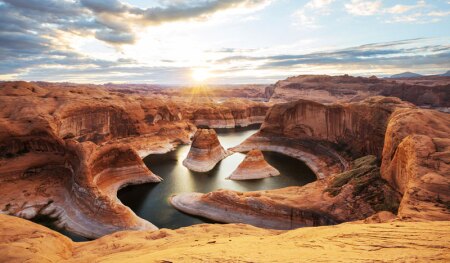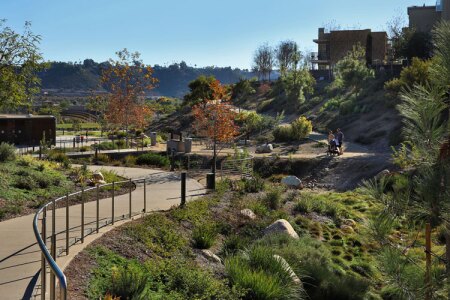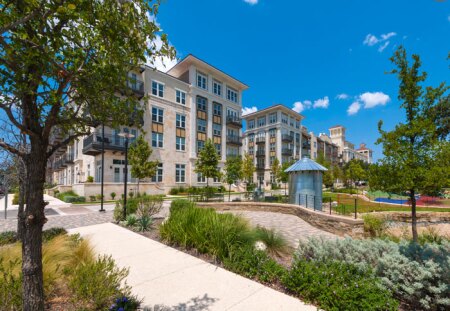“When the well is dry, we know the worth of water.”―Benjamin Franklin
Across half the world—including half the United States—record-breaking droughts, extreme heat, and megafires exacerbated by climate change have established a “new normal” that challenges the future of development and growth.
Groundwater and surface water vital to communities, agriculture, and ecosystems are drying up. Wildfires devour buildings and homes in increasingly urban areas, where the land has become hot and dry. When the rains finally come, they cannot infiltrate the scorched earth, leading to deadly floods. The frequency, intensity, and duration of droughts and their cascading, interconnected impacts are increasing, and this pattern is expected to continue.
With the combination of water scarcity, population growth, and water quality issues, many communities are beginning to forecast an inability to accommodate future water needs. Some of these communities are halting real estate development, and others are requiring that developers acquire their own water supplies, which is increasingly challenging and expensive. These measures adversely affect real estate markets and affordability.
A Better Alternative to Halting Growth
“Back then, we were considered one of the biggest water-wasters in the West.”—John Stomp, chief operating officer, Albuquerque Bernalillo County Water Utility Authority
In 1992, Albuquerque, New Mexico, learned that its aquifer—the sole source of drinking water for its then 400,000 residents—was rapidly running out of water. Not only did the aquifer contain far less water than previously believed, but it was also being pumped twice as fast as nature was replenishing it.
Rather than deny the reality or halt growth, Albuquerque took action. They started with a water conservation program to reduce water demand. The Albuquerque Bernalillo County Water Utility Authority fixed leaks in its distribution system and offered rebates to encourage customers to update older fixtures and appliances with more efficient versions. It educated residents about outdoor irrigation, reducing water waste, and paid locals to convert lawns to drought-tolerant landscaping. It began pricing its water with an increasing block rate structure through which the unit cost of water increases as water use rises, thus incentivizing customers to conserve water.
These efforts halted depletion of the city’s aquifer by the year 2000, despite population growth. Albuquerque’s total water demand per capita has dropped 50 percent since the conservation program began in 1995. In addition to water conservation, water reuse is now part of the city’s water portfolio. Industrial effluent is treated and repurposed for parks and golf courses and reclaimed wastewater from the Water Authority’s sewage treatment plant is delivered to irrigation customers.
These efforts continue to this day and have allowed Albuquerque to meet the city’s water needs for at least 100 years, despite an arid climate, extreme drought, and population growth.
“We don’t need any new water for 100 years. We don’t plan to buy any more water rights or import any more water.”—Katherine Yuhas, water conservation officer, Albuquerque Bernalillo County Water Utility Authority
Taking Action across Sectors
While every community is not as proactive as Albuquerque has been, that does not mean the rest of us should throw up our hands and wait for the worst.
Real estate and land use professionals are already leading the way with innovative solutions. In June 2022, ULI released the report Water Wise: Strategies for Drought-Resilient Development, which features best practices and case studies for incorporating water-saving measures into real estate development projects, alongside policy recommendations for integrating land use and water management.
The report finds that investing in water efficiency and conservation measures at the site scale mitigates the risks of water shortages, policy changes, and rising water prices. It also garners water and energy cost savings, increasing asset value and providing long-term value to owners and investors alike.
Strategies for Drought-Resilient Real Estate
Despite diminishing freshwater supplies, increasing water conservation and efficiency will allow future population and economic growth to occur in a sustainable way. Since real estate development and land use patterns have a substantial influence on the efficiency of water use and the impact of water shortages, real estate developers and land use professionals have a significant role to play.
Water Wise: Strategies for Drought-Resilient Development offers recommendations for water-smart development and landscaping that are organized into sections for pre-development, indoor, outdoor, ongoing management, and public policy strategies. The following examples demonstrate how water-smart strategies can provide co-benefits, enhancing the bottom line of real estate projects while also supporting the long-term sustainability of communities and environments.
Water-smart site selection: Compact, walkable, and water-efficient development accommodates growth without increasing the burden on the local water system. Selecting previously developed sites for redevelopment takes advantage of existing utilities and infrastructure and preserves natural ecosystems and farmland.
As an example, Sudberry Properties has transformed a 70-year-old sand and gravel quarry into Civita, a water-smart, mixed-use urban village in San Diego’s Mission Valley organized around a network of parks and open space. Civita uses an array of strategies to conserve water, including water-efficient fixtures, smart meters and irrigation, native landscaping, and water treatment and reuse. These investments allow the property to control its water destiny and foster a vibrant, sustainable lifestyle for its residents.
Water-efficient fixtures and appliances: The more properties use water-efficient fixtures and appliances, the more water, energy, and money can be saved. As of 2016, only 37 percent of homes studied had water-efficient toilets and 46 percent had water-efficient clothes washers. Opportunities for greater water efficiency arise every time older fixtures and appliances are replaced. In addition, increasing the availability of customer-facing and real-time water use data with smart meters supports leak detection and water use reduction.
As part of a larger renovation program from 2014 to 2018, real estate investment management company Clarion Partners replaced bathroom fixtures across its hotel portfolio to improve water conservation and efficiency. With low-flow toilets, faucet aerators, and water-efficient showerheads, the hotels in Clarion’s portfolio have achieved an annual average savings of $17,250 and over 600,000 gallons (2.3 million liters) of water per hotel.
Water reuse: Potable water can be further conserved by reusing nonpotable water. Rainwater, stormwater, graywater, blackwater, air-conditioning condensate, and foundation drain water are all sources of water that can be leveraged on site. Since each site’s ability to capture, treat, and convey on-site alternative water sources varies, it is wise to evaluate the feasibility of potential sources to determine cost implications and payback periods, since water reuse can be expensive. Also, local regulations concerning water reuse vary. Despite these potential challenges, the global market for water recycling and reuse technologies is estimated to grow from $21.3 billion in 2021 to $40.5 billion by 2026.
Colorado’s largest water utility, Denver Water, aims to use the most appropriate source water for each water use. The utility’s new administration building features rainwater capture for irrigation and on-site graywater and blackwater treatment and recycling. The building’s water recycling system is capable of recycling up to 7,000 gallons (26,500 liters) per day, which is more than enough to meet the site’s water demands, especially in combination with its low-flow plumbing fixtures.
Climate-appropriate landscaping: Throughout arid and semi-arid regions of the U.S. West, outdoor irrigation is often the single greatest use of water. By altering outdoor water use, significant savings are possible, with estimates ranging from 35 to 75 percent of current per capita water use.
Water-smart and drought-resilient landscaping includes everything from soil preparation and the selection of climate-appropriate plants to the installation and maintenance of irrigation systems, green infrastructure, and permeable hardscapes. These strategies have a variety of benefits, including a reduction in water demand, productive use of stormwater, decreased flood risk, groundwater recharge, and ecosystem support.
At the Residences at La Cantera in San Antonio, Texas, J. Robert Anderson Landscape Architects advanced a drought-tolerant landscaping strategy around the 1.5-acre (0.6 ha) park on the site featuring a plaza, lawn space, an adventure playground, a pond, and picnic areas. The team grew native and drought-tolerant plants and installed mulched landscape beds at least four inches (10 cm) deep to retain moisture from irrigation. A 10,000-gallon (37,900 liter) cistern next to the site’s wet pond captures rooftop runoff and condensate from air-conditioning equipment piped from the site’s buildings. The water collected is then used to irrigate the park and renew the pond’s water. The site saves an estimated $8,840 in annual water charges and the owners have estimated $500,000 in added asset value.
Double net zero: Since water use requires a substantial amount of energy, water and energy are fundamentally linked. Frequently, however, water and energy are targeted for savings separately. By addressing both, greater savings are possible.
KB Home, an Environmental Protection Agency–recognized homebuilding company, created the Double ZeroHouse to pursue both net zero energy and net zero water with its homes. Each Double ZeroHouse produces as much energy as it uses in a year with solar panels and collects enough water to irrigate its landscape through an on-site graywater recycling system. Combined with WaterSense-labeled fixtures, Energy Star–certified dishwashers, real-time water meters, and water-efficient landscaping, Double ZeroHouses conserve up to 100,000 gallons (378,500 liters) of water annually (for a household of four) compared with a typical home. Homeowners save around $2,700 per year on utilities and over $100,000 in the first 30 years, accounting for increasing utility costs. These savings can quickly offset the initial construction and technology costs, which are financed over the life of the mortgage.
The Worth of Water
Overall takeaways from the best practices in Water Wise: Strategies for Drought-Resilient Development are that saving water saves money and generates long-term value for real estate assets, communities, and the environment.
As water becomes scarcer, the costs of accessing it increase—not only because of limited supply, but also as a result of expensive infrastructure investments necessary to treat and transport it, and government pricing mechanisms to encourage water conservation. Water is also becoming more expensive as developers, investors, governments, and others increasingly turn to the market to purchase access to water.
The cumulative result is that water costs, when added to other development and land acquisition costs, can act as a development constraint. Developers can sidestep this constraint through water conservation and efficiency measures. In addition to requiring less water, water-smart development can take advantage of conservation-oriented system development charges (A.K.A. tap fees) that lower costs for less potable water use and other local incentives for water conservation.
Investing in water efficiency and conservation measures at the site scale will also be a way to get ahead of the curve of coming policy changes. These changes will have a material impact on what types of real estate can be developed, as well as where and how.
Luckily, consumers are increasingly showing a preference for water-efficient fixtures, appliances, buildings, and landscapes, especially in arid regions. Developers who integrate water efficiency and conservation into their projects help end users save water and money, ultimately supporting more equitable and sustainable environments.
Since potable water is in increasingly limited supply, reducing demand for water through water conservation, efficiency, and reuse generates social, environmental, and economic benefits for people, buildings, and communities. These strategies are relatively affordable and allow for continued growth. Working together across sectors on water conservation, efficiency, and reuse can help protect our water future despite projected water shortages, population increases, and climate change.
For more information about ULI’s drought resilience efforts, visit the Urban Resilience program’s Drought Resilience webpage.












